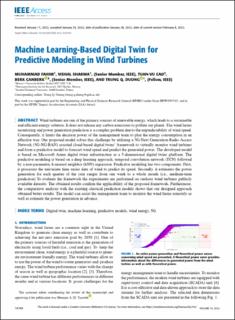| dc.contributor.author | Fahim, Muhammad | |
| dc.contributor.author | Sharma, Vishal | |
| dc.contributor.author | Cao, Tuan-Vu | |
| dc.contributor.author | Canberk, Berk | |
| dc.contributor.author | Duong, Trung Q. | |
| dc.date.accessioned | 2022-02-28T13:15:33Z | |
| dc.date.available | 2022-02-28T13:15:33Z | |
| dc.date.created | 2022-02-24T08:37:31Z | |
| dc.date.issued | 2022 | |
| dc.identifier.citation | IEEE Access. 2022, 10, 14184-14194. | en_US |
| dc.identifier.issn | 2169-3536 | |
| dc.identifier.uri | https://hdl.handle.net/11250/2981738 | |
| dc.description.abstract | Wind turbines are one of the primary sources of renewable energy, which leads to a sustainable and efficient energy solution. It does not release any carbon emissions to pollute our planet. The wind farms monitoring and power generation prediction is a complex problem due to the unpredictability of wind speed. Consequently, it limits the decision power of the management team to plan the energy consumption in an effective way. Our proposed model solves this challenge by utilizing a 5G-Next Generation-Radio Access Network (5G-NG-RAN) assisted cloud-based digital twins’ framework to virtually monitor wind turbines and form a predictive model to forecast wind speed and predict the generated power. The developed model is based on Microsoft Azure digital twins infrastructure as a 5-dimensional digital twins platform. The predictive modeling is based on a deep learning approach, temporal convolution network (TCN) followed by a non-parametric k-nearest neighbor (kNN) regression. Predictive modeling has two components. First, it processes the univariate time series data of wind to predict its speed. Secondly, it estimates the power generation for each quarter of the year ranges from one week to a whole month (i.e., medium-term prediction) To evaluate the framework the experiments are performed on onshore wind turbines publicly available datasets. The obtained results confirm the applicability of the proposed framework. Furthermore, the comparative analysis with the existing classical prediction models shows that our designed approach obtained better results. The model can assist the management team to monitor the wind farms remotely as well as estimate the power generation in advance. | en_US |
| dc.language.iso | eng | en_US |
| dc.rights | Navngivelse 4.0 Internasjonal | * |
| dc.rights.uri | http://creativecommons.org/licenses/by/4.0/deed.no | * |
| dc.subject | Machine learning | en_US |
| dc.title | Machine Learning-Based Digital Twin for Predictive Modeling in Wind Turbines | en_US |
| dc.type | Peer reviewed | en_US |
| dc.type | Journal article | en_US |
| dc.description.version | publishedVersion | en_US |
| dc.source.pagenumber | 14184-14194 | en_US |
| dc.source.volume | 10 | en_US |
| dc.source.journal | IEEE Access | en_US |
| dc.identifier.doi | 10.1109/ACCESS.2022.3147602 | |
| dc.identifier.cristin | 2005025 | |
| cristin.ispublished | true | |
| cristin.fulltext | original | |
| cristin.qualitycode | 1 | |

